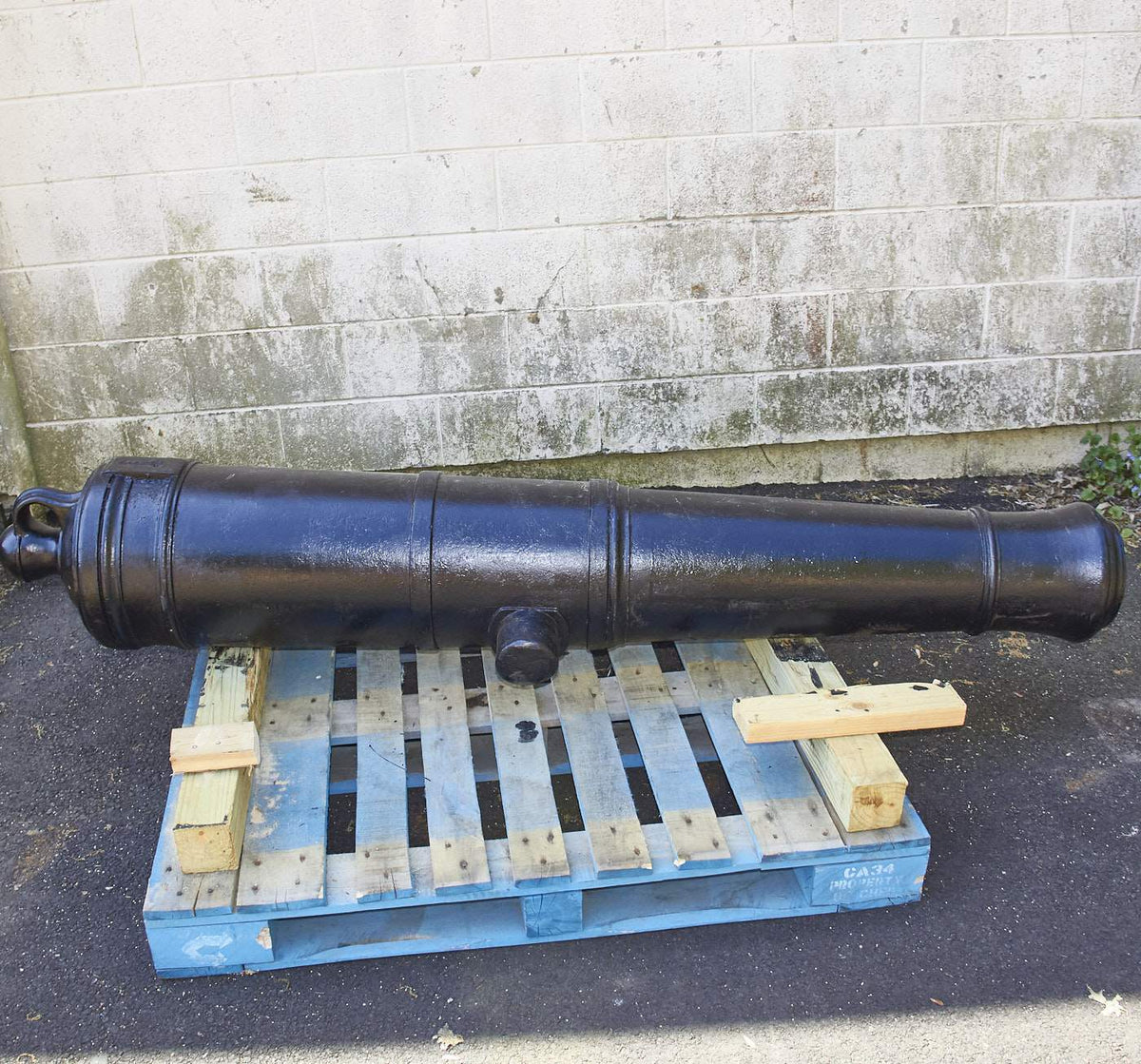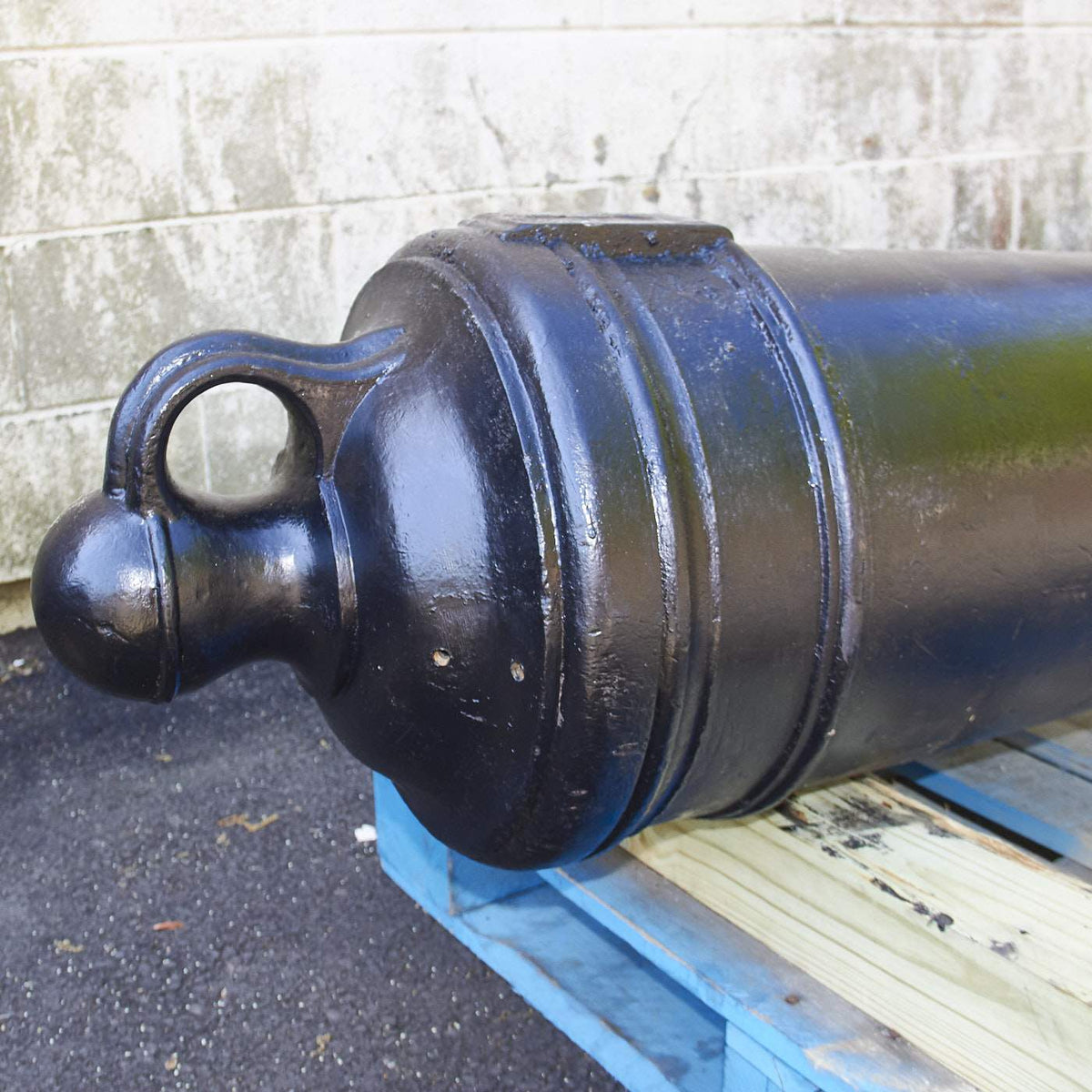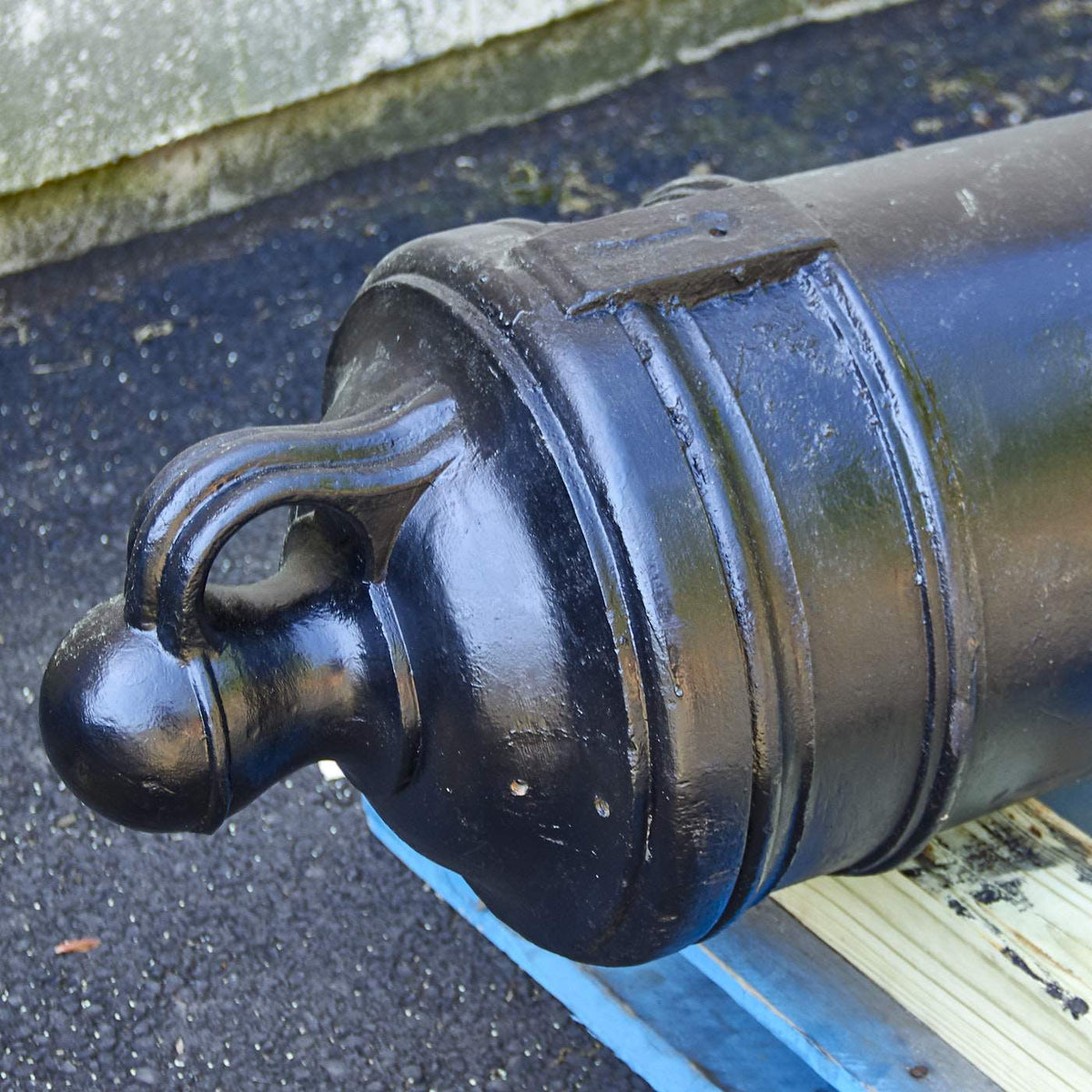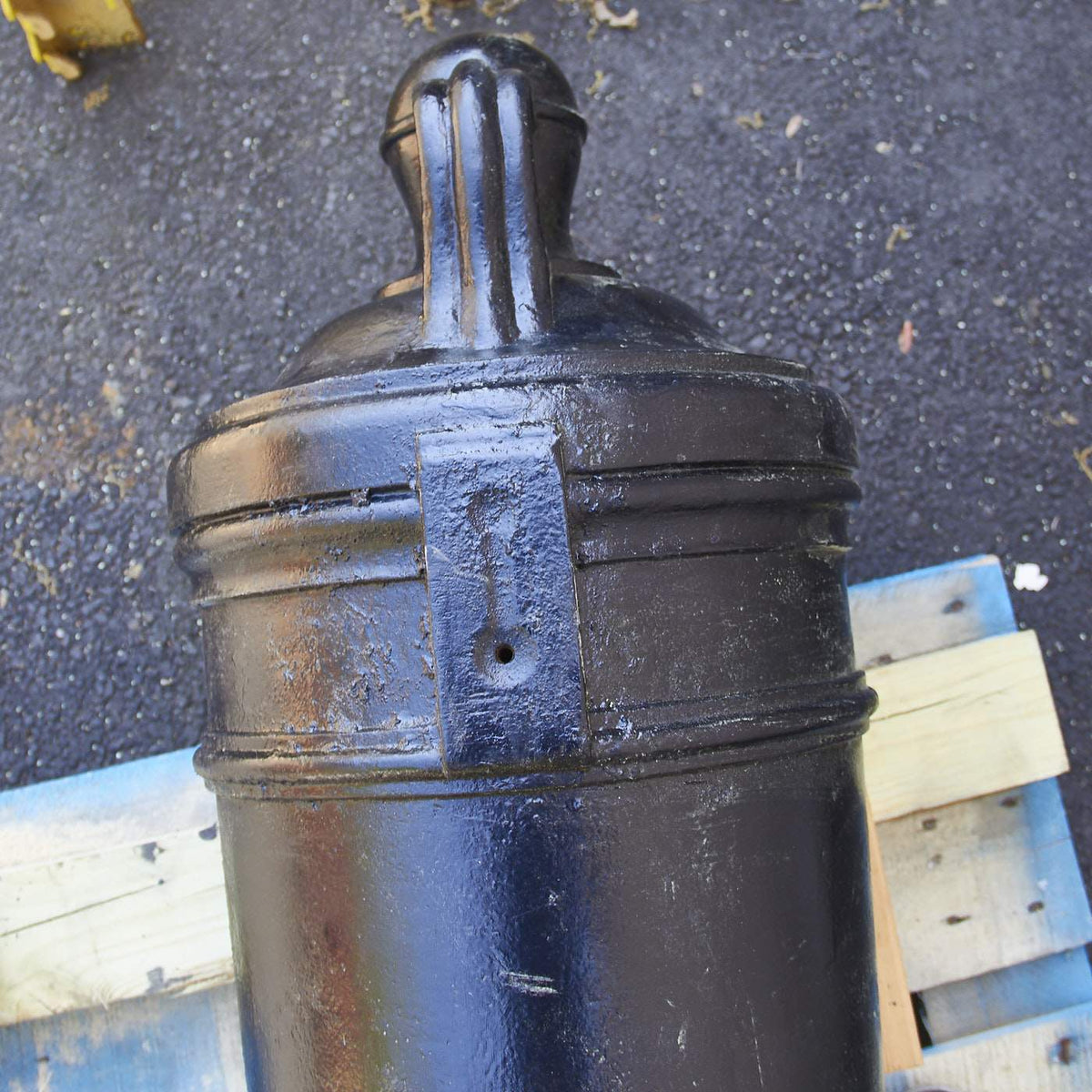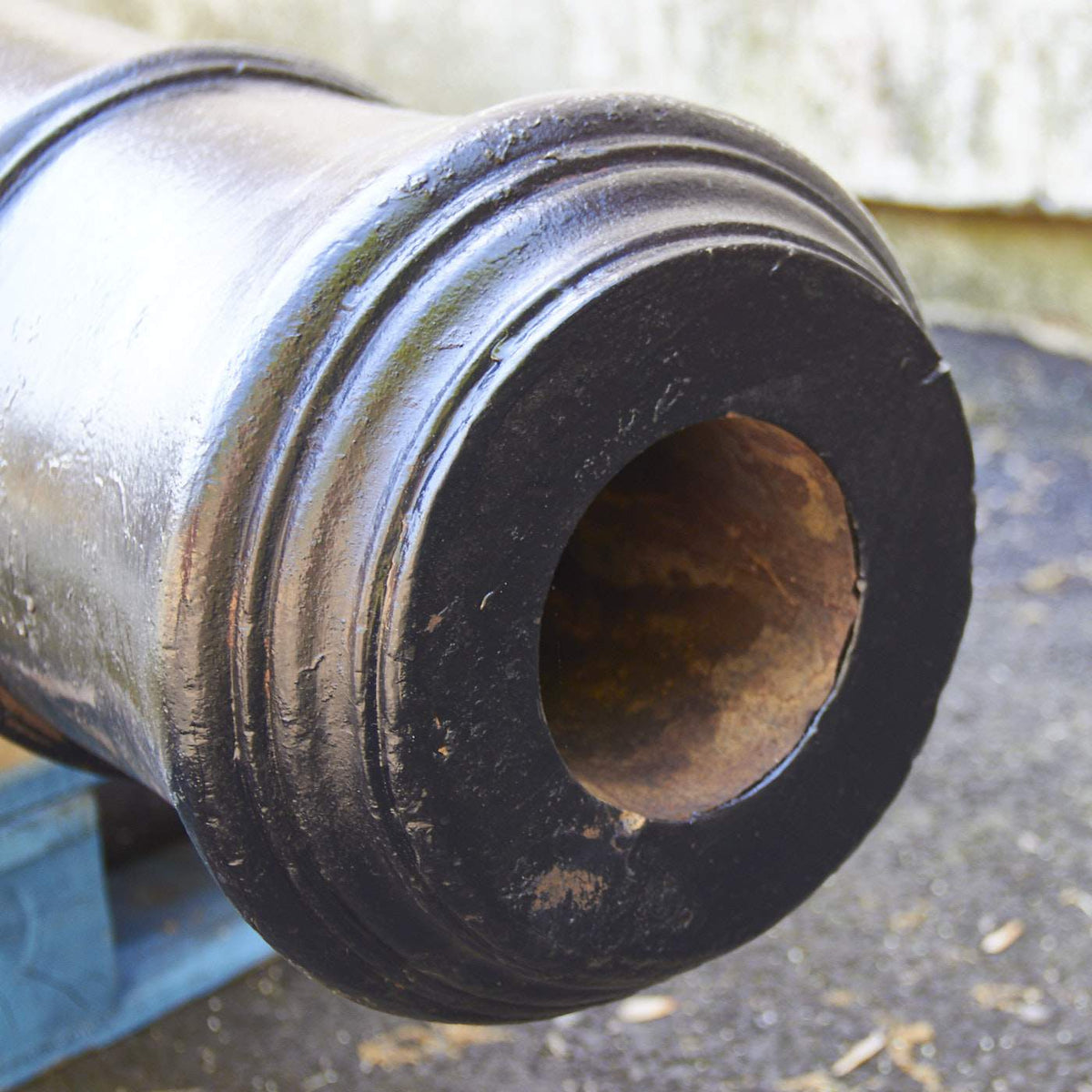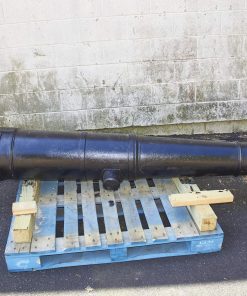Original Early 19th Century Iron Bloomfield Pattern 9-Pounder Ship’s Cannon Original Items
$ 14.995,00 $ 3.748,75
Original Item: Only One Available. This is an early 19th century 9 pounder Bloomfield Pattern Iron Cannon. Based on the design and high quality of Iron composition and casting technique, we believe this example to be British manufactured. However, it does not have any visible markings. It features the characteristic cast iron multi stage body with plain trunnions and typical Bloomfield style cascabel, the breech is unmarked, we believe the markings we struck after it was taken to the Asian Subcontinent by the British East India Company. It was discovered and recovered from Kathmandu, Nepal in 2003. It measures 7′ (84″) in overall length and has a 4″ bore denoting it as a 9lb. The touch hole is clear (not spiked) as is the entire length of the tube. The cannon has been freshly painted and is ready for inside or outdoor display.
Watch IMA’s own antique gun expert Alex evaluate and fire a bronze cannon on History Channel’s Pawn Stars:
Once John Armstrong had finished his basic design for British artillery in 1725, there were only marginal changes to the template over the next 70 years.
That changed In 1780, when a 36 year old artillery captain was appointed as Inspector of Artillery and Superintendent of the Royal Brass Foundry.
Thomas Bloomfield, son of the Rev. Thomas Bloomfield, rector of Hartley and Chalk, Kent, and Chaplain to the Duke of Dorset, was born in 1744.
When he was 11 years old he was sent to sea on HMS Cambridge (80) under a close friend of his father, Sir Peircy Brett. His naval career was short lived and in February 1758 he enrolled as a cadet at the Royal Military Academy at Woolwich.
He was a talented student, gained the notice of his professors and passed out as a lieutenant eleven months later at age 15. He saw combat in the West Indies and Florida. He became aide de camp to General Conway, who was then acting Master General of the Ordnance and was retained in that position by his successor, Lord Townshend.
He resigned that high profile post to serve in the war in America. He was wounded in the head at Saratoga, returned to his duties as aide to the Master General of Ordnance. In 1780 he was appointed Inspector of Artillery and Superintendent of the Royal Brass Foundry.
At the time Britain’s military administration was virtually belly up. The nearly medieval system of military administration used by Britain was obviously incapable of supporting an army and navy engaged in a worldwide war.
Blomefield set about his task with energy. In his first year he condemned 496 new artillery pieces and unsuitable before they were sent to the army or the fleet. This represented about a quarter of the national production.
Around 1783, Blomefield set his hand to designing artillery. Apparently he was a dedicated experimenter and used his experiments to inform his designs. There are several key deviations from the Armstrong-Frederick pattern gun in the Blomefield gun.
First, it is much more simple in design. A lot of the more decorative features at the cascabel were done away with to ensure a uniform thickness of metal.
Second, an attempt was made to lessen the weight of the gun by trimming the thickness of the tube while retaining a strong breech. This is a theme one sees with cast iron guns probably culminating in the Parrot guns
Third, the chamber for the powder bag was a bit larger in diameter than the bore. This resulted in a better burn rate for the powder and hence a higher muzzle velocity.
Lastly, a loop was forged over the knob on the cascabel. Aboard ship, this enabled the breeching rope to pass through the loop rather than being looped around the knob. This subtle change enable shipboard artillery to be shifted much farther off the center line because it could be fired with the risk of snapping the breeching rope.
After 1794 the Blomefield pattern gun was the standard within the Royal Navy.
See schematic scan for detailed measurements.
Curbside delivery within the continental US is included with purchase. Customers outside the continental US should contact us for an accurate shipping quote.
Fast Shipping with Professional Packaging
Thanks to our longstanding association with UPS FedEx DHL, and other major international carriers, we are able to provide a range of shipping options. Our warehouse staff is expertly trained and will wrap your products according to our exact and precise specifications. Prior to shipping, your goods will be thoroughly examined and securely secured. We ship to thousands clients each day across multiple countries. This shows how we're dedicated to be the largest retailer on the internet. Warehouses and distribution centres can be located throughout Europe as well as the USA.
Note: Orders with more than one item will be assigned a processing date depending on the item.
Before shipping before shipping, we'll conduct a thorough inspection of the items you have ordered. Today, the majority of orders will be delivered within 48 hours. The delivery time will be between 3-7 days.
Returns
The stock is dynamic and we cannot completely manage it because multiple stakeholders are involved, including our factory and warehouse. So the actual stock may alter at any time. It's possible that you may not receive your order once the order has been made.
Our policy is valid for a period of 30 days. If you don't receive the product within 30 days, we are not able to issue a refund or an exchange.
You can only return an item if it is unused and in the same state as the day you received it. You must have the item in its original packaging.
Related products
Uncategorized
Uncategorized
Uncategorized
Uncategorized
Armoured Fighting Vehicles of the World: AFVs of World War One (Hardcover Book) New Made Items
Uncategorized
Uncategorized
Armored Burgonet Helmet & Polearm from Scottish Castle Leith Hall Circa 1700 Original Items
Uncategorized
Uncategorized
Uncategorized
Uncategorized
Uncategorized
Band of Brothers ORIGINAL GERMAN WWII Le. F.H. 18 10.5cm ARTILLERY PIECE Original Items
Uncategorized
Uncategorized
Angolan Rebel 1970s era 60mm Inert Display Mortar from Angolan Civil War Original Items
Uncategorized
Uncategorized
Uncategorized
Uncategorized
Uncategorized
Uncategorized
Uncategorized
Uncategorized
